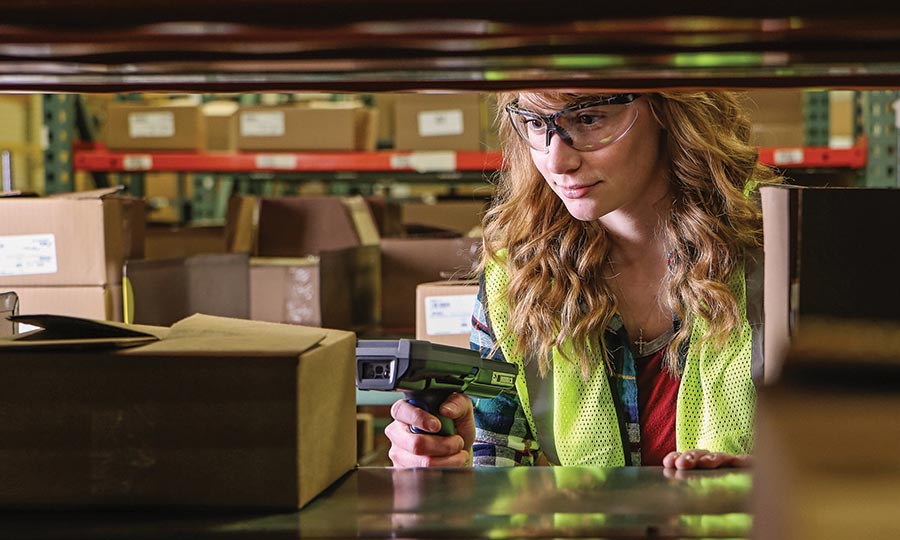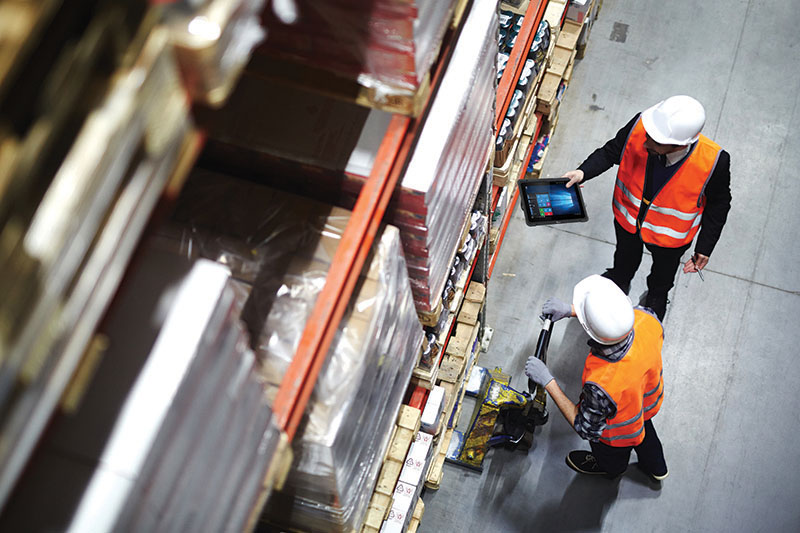Warehouse mobility learns new moves
In 2010, Apple trademarked “There’s an app for that.” A decade later, the warehousing and distribution community is putting the claim to the test as device capabilities and wireless infrastructure converge.
Like a carpenter’s tool belt, mobile devices are critical to the performance of frontline warehouse workers. A worker cannot be effective if they’re not equipped with the right tools at the right time. But, unlike mobile devices, vastly improved hammers don’t hit the market every 18 months, leaving those with last year’s hammer to fall behind.
Historically, the management of mobile devices and edge software has largely resembled other asset management techniques in the warehouse. Purchased based on performance specs and lowest bids, the equipment is worked hard for as long as possible and refreshed every decade or so. Not anymore. Driven by fierce competition for workers and customers, the modern approach to mobile device management is now mirroring the consumer space, where device updates, upgrades and add-ons are frequent and minimally disruptive to the user.
To put it mildly, disruption is in no short supply these days. Pat Nolan, research analyst for VDC Research, cites recent warehousing studies, survey data and interviews with solution providers, end users and warehouse leaders. The research indicates record low openings in warehouse facilities, which is in direct conflict with healthy growth.
“One of the biggest challenges that is apparent is the space conundrum,” Nolan says. “As they attempt to expand, the challenge is to optimize spaces they currently have and one way is with increased focus on frontline mobility.”
The first step, he says, is to explore the ecosystem of technology partnerships. The less a warehouse operation has to worry about mobile devices themselves—and the more technology partners can handle them—the better, he says.
Another critical focus is ease of use. When mobile technology changes and proliferates, you risk overwhelming instead of empowering frontline workers. Few carpenters wear two or more tool belts.
“Cost will always be the No. 1 priority, but ease of use separates operations that are innovators and those that fall behind,” Nolan says. “Cost is important, but don’t let it drive every decision.”
Sunset, sunrise
As of January, Microsoft no longer supports Windows Embedded CE 6.0, Handheld 8.1 or Handheld 6.5 operating systems (OS). The sunset was announced a couple years ago, well short of the typical enterprise device lifecycle, and it foretold a time when users would be empowered to never again face such vulnerability. Having made some early inroads in logistics and rugged warehouse applications, Google’s Android OS quickly became the heir apparent.
“Until something else comes along,” says Greg Henry, vice president of client solutions for system integrator Barcoding Inc., “Android by far will be the leading OS in the ruggedized space. The technology partner ecosystem is much, much bigger than we ever saw with Windows CE. The tools are better and third-party support resources are stronger than they have ever been.”

Using modular hardware and apps, mobile device makers are working to ensure users can easily adopt the latest tech.
Those migrating from Windows to Android should think of it as enhancing, not replacing, existing technology, Henry says. Voice-enabled apps on Android, for example, have overcome most early issues and are at the quality of landlines, Henry says. The same device can now replace walkie talkies and other communication devices, freeing valuable space in the tool belt.
“The camera tech on devices now is incredible,” Henry adds, citing apps that, for example, can capture images of damaged items.
Customers have either completed or are on their way to moving to Android-based infrastructure, says Mark Wheeler, director of supply chain solutions at Zebra Technologies. Inherent in the OS is the ability to develop apps that can understand the device they’re on and optimize for it, he says. If that means a landscape view on a wrist screen or portrait view on a handheld, software is available to execute workflows without separate sets of code. This saves IT time and effort on the back end and can unify the user experience across devices. Wheeler says customers should be enabled to choose the best device and form factor for an application and deploy it quickly.
Given the number of green screens still used in the warehouse, “quick” could take some getting used to. Henry suspects such users will like what they find.
“What’s really cool about Android today, specifically for the warehouse, is the vast majority who still run Telnet emulation and green screen interfaces can use apps for Android to modernize those and give the user a more graphical user interface,” Henry says. “It’s more intuitive and easier to learn, but for legacy users who want to stay with the traditional Telnet, they can run both old school and new school modes.”
Come together
Although navigating another app store might sound like a chore, a central goal of modern hardware and software design is to reduce complexity.
“A lot of the legacy issues have to do with assuming a physical keyboard is on every device,” Wheeler suggests. “So, if it’s a Telnet or browser user experience, it’s assumed all data is presented and all data entry is possible.”
A range of keyboards, including some with just a few buttons worn on the worker’s arm, are available. If a task is numeric, for example, screens won’t prompt for alphabetic entry. After all, Wheeler says, “if only two choices are possible, don’t present 10.” Of course, this sort of contextually aware input requires a fairly specific workflow and software, he says, but is dramatically less cluttered.
“Customers are finding it a much more productive environment, with much better information, visibility and access to tools that drive higher utilization and a richer experience for the operations team,” Wheeler says. “High double-digit productivity gains make operations folks happy.”
To make sure they stay happy, it’s important the technology be future-proof, according to Mike Noyes, general manager of mobility scan and print services for Honeywell SPS. Wheeler and Noyes each asserted that a unified hardware and software platform is the best way to optimize and simplify management of mobility solutions while keeping pace with rapid innovation.
“We aren’t back to the drawing board with housing, mechanical or software,” Noyes says. “It becomes drop-in tech. Those who adopt at launch still have options to advance operations without turning over devices. Instead, they can roll through the innovation lifecycle of these products, swap apps and migrate up the technology curve.”
Device makers aren’t the only ones advocating early adoption. Henry offers an integrator’s perspective. Patches every six to eight weeks and significant annual updates are great, but future-proofing will still require periodic investments in new devices, he says—likely in increments of as little as five years.
“Technology is changing that fast,” he says. “Get the most recent version of a device you can. The manufacturing community is willing to support releases for three to five years. If the latest device is in its first year, you will get the bang for your buck.”
Henry is also a proponent of mobile device management (MDM) solutions, which are critical for large enterprises and valuable to small ones. Even if you only have 20 devices, he says, touching each is painful and takes them out of service for some time. Cloud-based MDM tools, however, don’t require infrastructure purchases.
Upping the ante
For all the ease on the solution side, modernizing mobile device management requires cultural change. This includes everything from simple habits like pocketing four worn-out batteries at the start of a shift to preventing worker concerns of over-surveillance. But, an interface harmonized across all devices, form factors and applications can create opportunities.
Eric Miller, CEO of JLT Mobile Computers, says although gamification might sound frivolous, it can have profound effects on engagement, retention and productivity. For example, when individual or group performance is made visible to everyone else, even routine processes in the warehouse can take on a competitive appeal.
“Workers want to do better, so update them in real time,” Miller says. “If you hit 100 packages for 300 days in a row, you better believe they will want to keep it alive for the rest of the year. That’s the power of gamification, changing how you engage employees, build processes and how things are done.”
VDC Research’s Nolan also highlights this theme, predicting device management’s growing role in leveraging frontline devices for data collection to optimize the entire operation. Nolan recently spoke to a warehouse manager who did a heat-mapping exercise with frontline devices.
“He saw where there was waste of space, time and movement, and they actually restructured the warehouse layout accordingly,” he says. “To help solve the space conundrum, the devices themselves served to generate data and improve space usage.”
Evaluating and investing are also slightly different games these days. Noyes says conventional wisdom is to define specs: scan distance, depth of field, memory, processor speed, etc. But, he says, these are just table stakes.
“Don’t get trapped in playing the spec position. Instead, really focus on workflow,” Noyes says. “What type of solution do you really need and what value does it deliver? Things like operational insight tools, asset performance management and worker performance management become pretty important topics.”
What’s changed, Miller adds, is the maturity of the tools, especially on the edge. Wireless infrastructure, cellular technology and MDM solutions can enable users to collect and analyze more data to improve productivity, revenues and profit. Better management of devices and people can offer meaningful insights into forklift driver activity, shipping and receiving operations and more.
Device selection used to be about the CPU or memory, or customers would agonize over committing to one type of wireless connectivity or another, but Miller says that’s going by the wayside.
“Now, it’s about supporting multiple operating systems and device variations for all sorts of equipment and connections,” Miller says. “Future-proofing is really about future-proofing your OS plans, then find an appliance to run the app.”
Companies mentioned in this article:
Barcoding Inc.
Honeywell SPS
JLT Mobile Computers
VDC Research
Zebra Technologies

Article Topics
Mobile & Wireless News & Resources
Manhattan Associates selects TeamViewer as partner for warehouse vision picking ProGlove and topsystem partner on hands-free picking solution CaPow’s power-in-motion solution eliminates charging downtime International Retailer Optimizes Efficiency Through Asset Lockers Writing the book on streamlined data capture 60 Seconds with Diego Vega from the Hanken School of Economics The Rebound: 3D Transformation at GE Appliances More Mobile & WirelessLatest in Materials Handling
Manhattan Associates selects TeamViewer as partner for warehouse vision picking ASME Foundation wins grant for technical workforce development The (Not So) Secret Weapons: How Key Cabinets and Asset Management Lockers Are Changing Supply Chain Operations MODEX C-Suite Interview with Harold Vanasse: The perfect blend of automation and sustainability Consultant and industry leader John M. Hill passes on at age 86 Registration open for Pack Expo International 2024 Walmart chooses Swisslog AS/RS and software for third milk processing facility More Materials HandlingAbout the Author
Subscribe to Materials Handling Magazine

Find out what the world's most innovative companies are doing to improve productivity in their plants and distribution centers.
Start your FREE subscription today.
April 2024 Modern Materials Handling

Latest Resources












